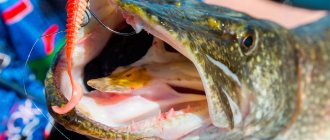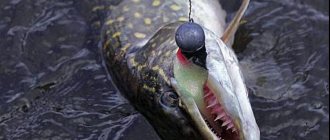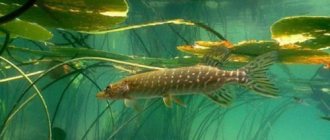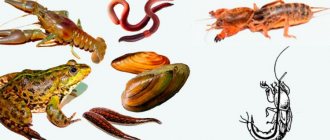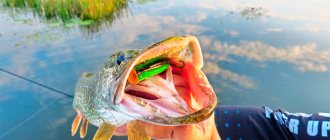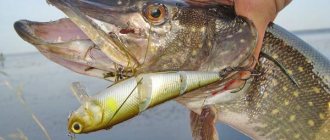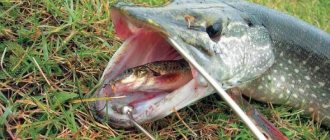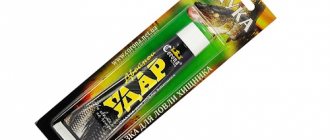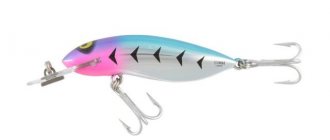Silicone lures for pike
Edible silicone baits for pike fishing are one of the most catchy types of bait when fishing for toothy ones. The proffish fishing store is the official dealer of the Lucky John company in Russia . From us you can purchase such legendary silicone models as Tioga, Bazara, Mister Greedy, Yoko Shaker, Ballist and others...
Large twisters Crusher Grub, classic Tioga, Fat Mr. are perfect for catching pike. Greedy, Lucky John Minnow and Joco Shaker. Both acidic and natural colors are suitable as recommended colors for pike fishing.
Classification of edible silicone
First of all, fishing rubber is classified according to its shape, the most common of which are vibrotail and twister. The third popular form in spinning fishing with a wide range of variations includes various slugs, one of the most famous imitations of which is the worm. Slugs are also released as aquatic larvae and abstract forms that resemble an insect, crustacean or underwater beetle.
Twisters and vibrotails differ in body structure and working element, which is the tail. In a twister, the tail is a crescent-shaped flat element, reaching the size of the main body in its length, and a vibrotail has a short but thick tail, like a horse’s hoof, which plays when retrieved due to a distinct thin transition from the main body of the bait.
In addition to its shape, silicone is classified according to its ability to play independently. Thus, active and passive baits are distinguished. Nozzles with active independent play are used for fishing in standing water bodies when fishing. Under these conditions, the requirements for the spinning technique are reduced for the spinner, since the bait compensates for this gap, independently achieving the attractiveness of the game.
When fishing water bodies with currents, use a passive bait with inert game parameters. In such conditions, the silicone works by resisting the forces of the current, achieving the animation style necessary to attract fish. Active silicone includes twister and, to a lesser extent, vibrotail, which can include both active and passive forms of the product. Slugs, for the most part, are considered passive baits, requiring the spinner to have the skill and ability to give the product a certain rhythm of play or to use them on reservoirs with moderate and strong currents.
What colors does pike like?
There are no specific colors or the most catchy baits that will present you with a pike “on a silver platter” with one hundred percent certainty. Everything again depends on the fishing conditions, namely on the quality and quantity of light and the optical properties of the water. There are only a few general recommendations, including:
- colors like real fish: shiny bronze, silver, “perch” colors;
- bright, provocative colors: acid yellow, red, green, etc.;
- classic black and red.
Practice shows that the color of the bait must be chosen for specific conditions: time of year, time of day, color of water, temperature and weather conditions.
Color of bait for pike in autumn
In autumn, cloudy days prevail, and the water tends to darken. In such conditions, it is worth choosing a brighter bait. If you are lucky enough to find yourself with a fishing rod on the river bank on a bright sunny day, use models with dull colors. In strong light, shiny and acidic colors only repel pike.
Winter time
In winter, when reservoirs are covered with ice, light practically does not penetrate into the water at all. Therefore, you should bet on lures of dark (black) colors or glowing in the dark. In general, when fishing on ice, you should give preference to baits that work not on color or shape, but on smell.
For murky water, use the brightest bait you have in your arsenal. You will not regret.
Advantages and disadvantages of fishing with edible rubber
Spinning fishing with rubber has a number of significant advantages and disadvantages compared to many other artificial spinning baits. One of the important advantages of silicone is its affordable price. Catching many species of predator involves difficult conditions of the bottom topography and the presence of vegetation, which causes frequent losses of baits, making them consumables, which the fisherman sooner or later has to come to terms with. The loss of silicone is not considered a catastrophic event, as in the case of the loss of an expensive wobbler, and this gives an advantage to the more frequent practice of using this type of bait in cramped, but promising conditions for the presence of predators.
The realism of the simulator's game can be safely attributed to the second important advantage of rubber. Few baits can boast of these qualities on regular even retrieves. Therefore, silicone is recommended for beginner fishermen who are just mastering spinning fishing techniques. The presence of an attractant in silicone only increases its attractiveness to predatory fish, and manipulations with odors help the spinner to hunt for a certain type of prey, based on its preferences when choosing a natural prey.
For an objective assessment of the product, it is worth focusing on a number of shortcomings that should be taken into account when using edible bait in order not to get into an uncomfortable situation in real fishing conditions by noticing the loss of the main working qualities of the bait.
First of all, you need to know that edible rubber has a certain shelf life, after which the attractiveness of the nozzle is lost. Even when containing silicone in sealed conditions, within a couple of years the bait dries out and becomes brittle or loose, losing elasticity and odor intensity. In addition, it is recommended that after each bite, and subsequently fishing, you check the silicone for critical damage and, if any, change the tool, because soft material is susceptible to destruction not only from the grip of the fish, but also from the constant interaction of silicone with the hook.
Varieties and features
All silicone baits can be divided into passive and active. The former do not create vibrations in the water; the fisherman himself must change the reeling speed and manipulate the top of the spinning rod to create movements. Active baits have their own distinct play in the water when retrieved.
Also, baits can be divided into imitation and fantasy. The first type is similar to the usual prey for pike, which it feeds on in its natural environment. The second variety does not imitate living creatures that live in bodies of water with predators.
There are nozzles made from regular and edible silicone . The predator senses the second option before the attack and tastes it after it has captured it in its mouth, due to which the hook sits tightly.
Edible silicone is more expensive, but it allows you to make even passive days of pike catchable.
Vibrotails
Visually similar to small fish, which is a common prey for a predator. It consists of a body with a lower keel and a tail, shaped like a hoof.
The bait moves in the water even with slow retrieval. Moreover, the bite doesn’t get worse from this. On the contrary, many fishermen note that most attacks occur while moving slowly. This is the main advantage of this type of nozzle.
In order for the vibrating tail to effectively perform its task, you need to pay attention to silicone when purchasing. It must be of high quality. The vibrotail is suitable for jig fishing.
Rice. 2. What vibrotails look like.
Twisters
This bait is not similar to the inhabitants of reservoirs. It consists of an elongated, embossed body and a hook-shaped tail. The corrugation can be flat and long, wide and narrowed. If the tail is elongated, the movements will be small and frequent. When it is wide - slow and powerful.
The quality of silicone does not play a special role. This is one of the best attachments for jig fishing, when active movements are required when diving to the bottom. This bait is cheaper than the previous type.
Rice. 3. What does a twister look like?
Worms
The two previous types belong to active baits, and worms belong to passive ones. That is, with a smooth approach, they will not attract a predator. This bait has an elongated body that can reach 30 cm. Large predators bite well on long models. Worms will be the best option when fishing with previous varieties does not bring results.
Rice. 4. What do silicone worms look like?
Slugs
Also refers to passive nozzles. They do not have a pronounced tail or legs that create vibrations. This bait is used less frequently than previous options, but it is recommended to have it in your collection because it can save you when the fish don’t bite at all.
The most important thing is to control it using the top of the spinning rod. The movements should be uneven so that the bait looks like sick and weakened prey. Slugs are suitable for jigging, diverting or twitching fishing.
Rice. 5. What do slugs look like?
frogs
Pike actively hunt frogs in the summer. Therefore, fishing with this bait is very effective. The attachment has a voluminous frog body and hind legs. For many models they move in the water. There are also options that allow you to avoid getting hooked in the thickets. A double is placed on them, which covers the sharp end.
The disadvantage of this option is its windage . That is, the bait cannot be cast far due to its large volume. Therefore, it is advisable to fish for it only in the coastal zone or from a boat.
Rice. 6. Frog bait.
Fantasy
They do not look like any inhabitants of the reservoir. They come in a variety of shapes and shades. At first glance, it may seem that this species will scare off a predator, because she does not know what it is. However, this is a misconception.
For pike, movement through the water is important, not shape. This bait will become an indispensable assistant when other baits do not work.
Rice. 7. Fancy baits.
Soft spinners
They are shaped like small fish, the surface is covered with soft silicone, and inside there is a load and a wire frame. There is no need to attach an additional sinker. This type of bait is rarely used, because... There is no particular need for them when fishing for pike.
Rice. 8. Soft spinners.
Choosing rubber for perch
Today it is no longer possible to imagine catching perch on a spinning rod without the use of edible rubber. The striped robber is caught in this way when the water is already quite cold, during the pre-winter period at the end of autumn and until freeze-up. As a rule, the size of the nozzle for imparting activity to a sluggish perch is not particularly important; anglers consider the color of the silicone to be the primary reason for attacks, which is the peculiarity of choosing a perch nozzle in relation to the selection of a tool for hunting pike perch and pike perch.
Promising perch colors include colors named Cola, Green Pumpkin, Nagoya Shrimp and Kiwi Seed. From the aromas, choose options for attachments that smell of fried fish, shrimp, squid and light flavors of non-tart spices. A bait whose smell is based on the taste of fish oil almost always works. For perch fishing, you can use silicones with a lower density, since fish attacks do not seriously affect the appearance of the fishing tool and rarely deform the bait with critical damage.
